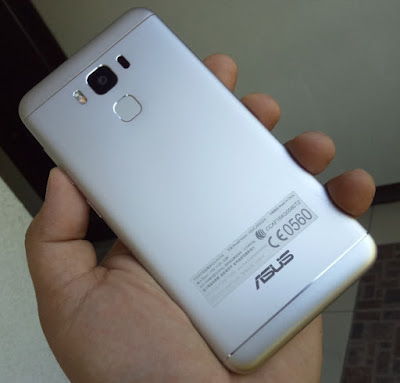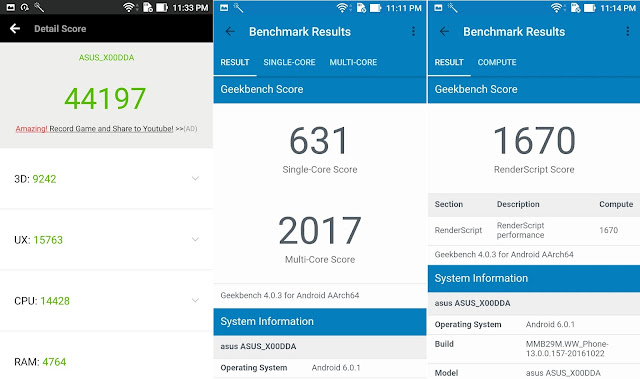 |
| ASUS ZenFone 3 Max ZC553KL Review; Supreme Potency |
INTRODUCTION:
The ASUS ZenFone 3 line was introduced to the local consumers a few months ago, including the battery life oriented variant. However, the one initially showcased to the public has a quad core chip that is inclined more towards the entry level segment. Thankfully, the Taiwanese manufacturing giant brought in its upgraded sibling that packs a bigger display and greater processing power, the ASUS ZenFone 3 Max ZC553KL.
PHYSICAL:
ASUS ZenFone 3 Max ZC553KL Video Unboxing and Hands-on
ASUS ditches the curved back design found on the ZenFone generation 1 and 2 devices, and moved on to a more flat, yet sophisticated footprint. Speaking of flat, the camera module on its back has no protruding lens, that is why I am giving it a plus point for aesthetics. Overall, the ASUS ZenFone 3 Max ZC553KL design embodies a metallic frame that feels premium in every grasp with properly contoured full slab of 2.5D glass up front. On a side note, there is no mention whether the glass is scratch-resistant or not, so better install a screen protector as early as possible to avoid being sorry in the future.
 |
| Display Information |
In terms of display size, it has a 5.5-inch touchscreen panel, that is about 0.3-inch bigger than the previous model, not to mention greater pixels too as it has Full HD resolution compared to the 720p of ZC520TL. The output is bright and viewing angles are great, which is expected for a device with 450nits and IPS panel. Meanwhile, legibility under direct sunlight is not the best I have seen, but more than enough to see and read what is on the screen.
 |
| Front |
Dimensions wise, it is obviously wider and longer than the 5.2-inch model, but surprisingly, its waistline is 0.25mm thinner. Meanwhile, when placed side by side with ASUS ZenFone 3 (ZE552KL), it managed to shrug off a few millimeters in length and width (151.4mm x 76.24mm x 8.3mm versus 152.6mm x 77.38mm x 7.69mm).
 |
| Back |
Moving on with the hardware, above the display is the secondary camera, earpiece grill, and hidden sensors, while below the screen are the non-backlit capacitive keys. At the top are 3.5mm audio jack and secondary microphone, the right has the volume keys and power button, the left part holds the SIM tray for micro SIM and nano SIM/micro SD card, the bottom houses the micro USB port, loudspeaker grill, primary microphone, and the retainer screws, and lastly, the back is the home of the main shooter, dual LED flash, laser auto focus sensor, and the fingerprint scanner.
 |
| Sides |
Some users reportedly experiencing intermittent fingerprint recognition, but I never encountered it with the unit I have, in fact, it is fast and accurate. By the way, it can also be used to perform tasks other than unlocking the phone, such as answering incoming calls, launching the camera, and taking photos. Sadly, there is no option to assign specific function.
SOFTWARE:
 |
| Software |
Like all the third generation ZenFone devices, it runs on Android Marshmallow with ZenUI 3.0 on top. The interface is similar, if not the same, with older ASUS smartphones, so if you have used any of it in the past, navigating the Max would be a breeze. Do not get me wrong here, those who haven't had one before does not need a doctorate degree to learn it, everything is relatively easy. However, custom UI is not for everybody, especially those who love the fluidity of stock Android. But then again, as I always say, proprietary interface gives a brand its own unique identifier.
PERFORMANCE:
 |
| CPU-Z Info |
The ZenFone 3 Max ZC553KL packs twice as much processing power than the previous Max model, it now has an octa core CPU clocked at 1.4GHz each as opposed to the 1.3GHz quad core of the ZC520TL. Not only that, it uses a more premium chipset, that is a Qualcomm Snapdragon 430 compared to the MediaTek MT6735 of the 5.2-inch variant. Below are its raw processing capabilities according to the criteria given by the popular benchmarking tools.
Antutu - 44,197
Quadrant - 19,913
NenaMark2 - 59.9fps
Geekbench - 837 (single core)
Geekbench - 4,095 (multi core)
Geekbench - 1,670 (renderscript)
PC Mark - 3,384
Vellamo Browser - 2,462
Vellamo Metal - 1,185
Vellamo Multicore - 1,794
 |
| ASUS ZenFone 3 Max ZC553KL Benchmark Results |
It is our first time to review a device with this kind of SoC, and based on the synthetic benchmark results, we can safely say that it matches the performance of the devices with Snapdragon 615 chip as well as those with MediaTek MT6753, such as ASUS ZenFone 2 Laser 5.5s and Cherry Mobile Flare Selfie respectively.
 |
| Sample Game - NBA 2K17 |
In terms of gaming capability, it can handle games slightly better than the Laser 5.5s, most likely because of the newer and better graphics processing unit, which is the Adreno 505. In fact, its performance is in similar level with the ZenFone 3 (ZE552KL) that has Adreno 506 GPU. That said, games like NBA 2K17 and Dead Trigger 2 are highly playable, smooth in normal settings and with little to no noticeable lag when the settings are cranked up to max.
There isn't much, or nothing at all to complain about its phone functionality, the call quality is good for both ends, no signal or reception issue encountered. Moreover, navigating between multiple apps is quick and easy, thanks to its 3GB of volatile memory, and if ever you find it kinda slow, just drag down the shortcut tray and click Power & Boost to optimize the phone.
CAMERA:
 |
| Camera UI |
The ZenUI 3.0 is uniform across all ASUS phones that have it, and the camera application is not an exemption. The interface is identical to other ASUS devices with all sorts of on screen buttons placed at the top and bottom. It also offers lots of shooting modes, starting with the sophisticated Manual that allows users to manually control the focus, ISO, shutter speed and EV, the Super Resolution that combines multiple shots to create a more incredible detailed images, Beautification to enhance digital output, and much more.
The handset's main gunner can shoot 16MP still, the highest resolution so far among all ZenFone Max variants. Not only that, its focusing mechanism is also laser guided, which allows for faster lock on target. In real life usage, it can focus in an instant and track the subject religiously, that is when there is ample lighting. However, focusing takes slightly longer, and sometimes a bit hit or miss when in low light conditions, so better hold the phone steady and take multiple shots whenever possible, or better yet, take advantage of its manual features.
I took it for a spin, and below are the some of the sample shots:
 |
| Day |
 |
| Afternoon (against the light) |
 |
| Afternoon (gloomy) |
 |
| Closeup |
 |
| Closeup (low light) |
 |
| Night |
As you can see above, the resulting images got fairly accurate colors with finely resolved details. The pictures are not that sharp when compared to more expensive smartphones in the market, but they are certainly above average in their own league. Yes, there are noises and grains, especially when there is less adequate light source, but they are only visible when the outputs are viewed full-blown on a computer.
On the other note, the rear-mounted camera can record videos up to 1080p resolution. It also has video stabilization mode, however, that is only available when the resolution is set to 720p or below. Meanwhile, the 8MP f/2.2 front-snapper is responsible for taking clear selfies and for making video chats or conferencing.
CONNECTIVITY:
The phone covers the basic connectivity requirements starting with dual SIM with fast mobile data connection via 4G LTE, WiFi, Bluetooth version 4.1 with A2DP & EDR, and a micro USB port with OTG function & supports reverse charging.
BATTERY:
 |
| Battery Stats |
For ASUS Android smartphones, the word Max on its name means having a huge or bigger battery than usual, and I am glad to say that it fared pretty well in this department. It scored more than 15 hours in PC Mark Work 2.0 Battery Life test, one of the highest results I personally encountered using this benchmark app. As a secondary driver, it managed to stay alive for five days with only 35% of its juice got sucked in. Meanwhile, heavy usage will render about 1.5 days of service on a single charge. Of course, the mileage depends on your usage, but the numbers I got with this one is already considered an impressive feat.
CONCLUSION:
The ASUS ZenFone Max ZC553KL is one of the most versatile handset you can buy, not only from the Taiwanese electronics firm, but also among all the players in the field today. It has a nice aesthetics, great build quality, an impressive battery life that lasts for more than a day, above average camera performance, and an attractive asking price. In short, it has a nice balance of specs-to-price ratio that will definitely give consumers a good run for their money.
ASUS ZenFone 3 Max (ZC553KL) Specifications:
- GSM:850/900/1800/1900MHz
- 3G: B1/2/5/6/8/19
- LTE: 1/2/3/5/7/8/18/19/26/28/38/41
- Dual (nano+micro) SIM, dual standby
- 5.5-inch IPS FHD (1920x1080) capacitive touchscreen display, 2.5D contoured glass
- Dimensions: 151.4mm x 76.24mm x 8.3mm
- Weight: 175 grams
- Android 6.0 Marshmallow with ZenUI 3.0
- 1.4GHz 64-bit octa core Cortex-A53 CPU, Adreno 505 GPU, Qualcomm MSM8937 Snapdragon 430 chipset
- 3GB of RAM
- 32GB internal storage, expandable up to 128GB via a micro SD card, uses SIM 2 slot
- 16MP f/2.0 auto focus (laser assisted) main camera with dual LED flash
- 8MP f/2.2 secondary camera
- Multimedia player
- 3.5mm audio jack
- FM radio
- GPS with A-GPS, GLONASS, BDS
- WiFi 802.11 b/g/n, Wi-Fi Direct
- Bluetooth v4.1
- Micro USB 2.0 with OTG
- Sensors: fingerprint, accelerometer, e-compass, proximity, light, gyroscope, hall
- Battery: 4100mAh Li-Ion, non-removable, supports fast and reverse charging
- Color: glacier silver, sand gold, rose pink, titanium gold
- Price: Php10,995

